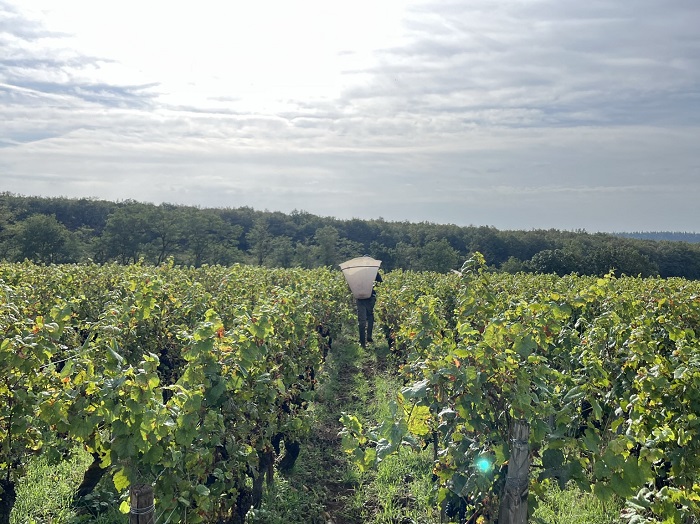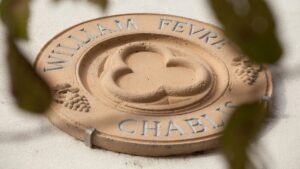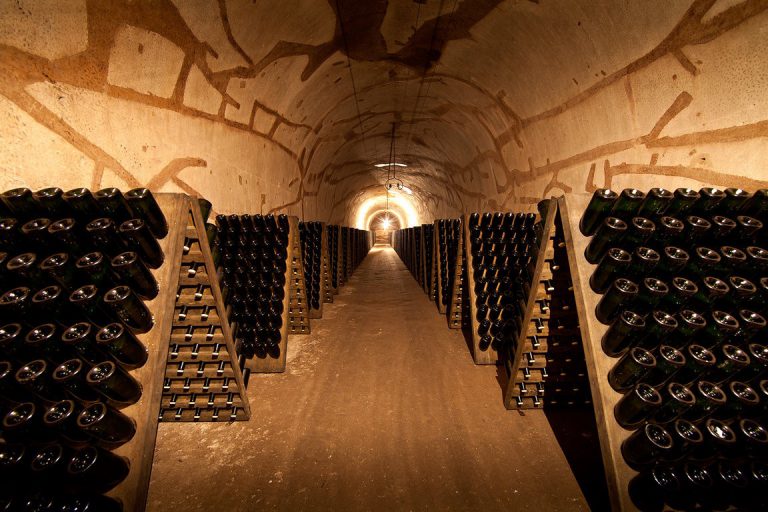
The final snips of the secateurs have brought in the French harvest. Even if the late-harvest grapes are still hanging on the vines, we can start to summarise the 2023 vintage. Contrasting – that’s the adjective that describes it the best.
2023 was a complicated year to manage for most French winemakers. Between drought (at the start of the “hottest July on record”), torrential rain (at the end of July), hot spells (not to mention the heatwave in August), hail and mildew that has attacked some regions, it has been a year of many ups and downs. All of this also occurred against the backdrop of high inflation and geopolitical tensions which influence exports and an increase in the price of raw materials.
If we look at the map of France, broadly speaking, the south felt the full force of wet weather and the west – except for the Loire – experienced mildew. Champagne, Alsace and Burgundy came through to the other side. However, the quantity is there, and France has overtaken Italy as the greatest wine producer in the world. According to Agreste, the statistic service from the French Ministry of Agriculture, and estimations taken on 1 September 2023, viticultural production could settle at nearly 45 million hectolitres this year, which is roughly the average seen in recent vintages (2018-2022). Quality also seems to be there.
Let’s take a quick tour of the French regions.
Bordeaux
Nearly 90% of the vines in the Nouvelle-Aquitaine have been affected by mildew, impacting the amount of grapes produced. This fungus took hold in spring when temperatures were higher than usual and there was a lot of rain. But all is not lost as the harvest is not over yet and despite everything, the quality is there.
Burgundy
Even though hail attacked several Burgundy vineyards and mildew was present, the damage was minimal and did not prevent a plentiful harvest. The Pinot Noir, with its maturity and quality, is more mixed than the Chardonnay which is beautiful and healthy in general.
The Rhône Valley
While the year is said to be promising, the days without rain have had a negative impact, tipping the balance so that there is more alcohol and less acidity but without ripening taking place. The challenge now is to lift it during vinification, something that can be done through the way varieties are blended in the southern Rhône. Springtime rain did the vines a world of good and the region ends the growing cycle in a good position, both in terms of quantity and quality.
The Loire Valley
All along the river, the vintage has been declared generous despite the changeable weather conditions by InterLoire (joint trade organisation for Loire wines). Welcome news after years with lower yields. However, some appellations did suffer, like Quincy and Reuilly.
Champagne
In Champagne, according to Agreste, the “grapes are well formed” and the diseases (powdery mildew broke out in July and mildew was also present) were “contained”. Global warming has benefited this region and the maturity of its grapes which was just as it should be in 2023. However, Champagne was not spared from the bad weather.
Languedoc-Roussillon
The region was cut in two with one part of it experiencing fairly usual weather and the other half feeling the full effects of a drought with 30%-60% lower yields than an average year. It’s an historically low yield, standing around 400,000 hectolitres (compared with 569,000 in 2022 and 756,000 in 2013). In Languedoc (Aude, Gard and Hérault), “the production wasn’t far off the average,” according to Agreste even if mildew and high summer temperatures attacked the vines, producing dry, slightly acidic grapes. The quality is there if vinification is carried out in an intelligent way to refind balance in the wines.
Alsace
If Alsatian winemakers were extremely afraid to see a repeat of the 2021 catastrophe (mainly caused by mildew) in 2023 due to the high amount of rain at the start of the summer, it was not without reason. With the changing weather conditions, winemakers worked flat out to achieve a promising, qualitative (with an interesting profile), and quantitative result.
Jura
In Jura, the year was also tiring for the winemakers who worked through the storms, late veraison caused by low temperatures and the quantity of grapes, and the presence of powdery mildew. The quantity is as it should be as is the quality with very healthy grapes.
Beaujolais
Quoting the president of Inter Beaujolais (joint trade organisation for Beaujolais wines): “From north to south, Beaujolais had all what was needed to create a brilliant vintage. As I was tasting the grapes as they slowly reached the perfect level of ripeness, I was absolutely surprised by the well-pronounced fruitiness, crunchy skin, seeds that tasted slightly of hazelnuts, and flesh that melted in the mouth.” Some good news about the quality as well as quantity which is higher than the previous five vintages despite several hail showers which were violent in places and other periods of bad weather throughout the year.
Corsica
Exceptional harvests were recorded throughout the island. The altitude, wind and ocean breezes protected the vineyards against all types of diseases. Only localised hail caused a few problems but the 2023 vintage is said to be beautiful.
Provence
The picture is very different the other side of the Mediterranean in Provence which saw hail, mildew, drought and black rot. A heatwave in August saved a small part of the harvest that was qualitative.
South-West
Mildew. Winemakers that we have crossed paths with only had this word to say. Unfortunately, yields have been heavily impacted by this disease despite all the hard work that winemakers put in fighting against it. Some have even lost 80% to 90% of their harvest. But what ends up in their bottles will be qualitative.
Savoie
Sun in August and rain in September was enough to make up for the bad weather winemakers faced throughout the year: a late spring frost, hail (some producers saw considerable damage which is the worst pain) and a heatwave. As it turns out, the harvest is healthy with grapes that were rehydrated before the harvest. And when it comes to the diseases, they were contained by the sun and wind.



